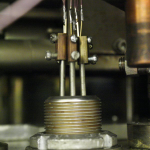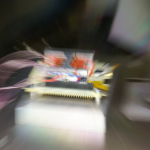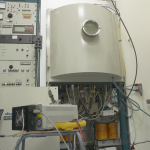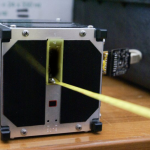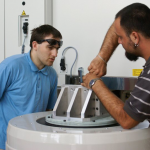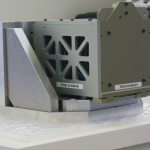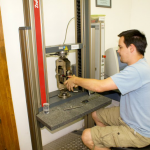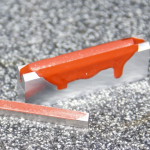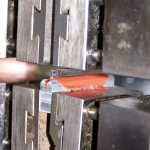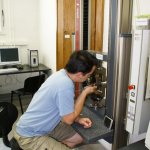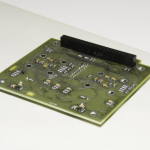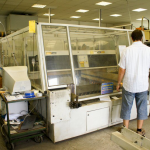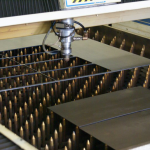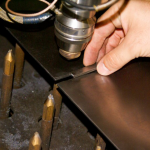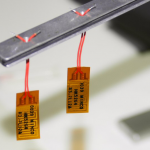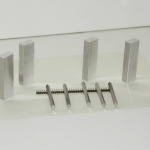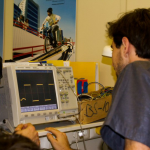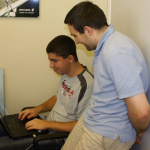The termo-vacuum test will be carried out from 12th July. However we observed the temperature behaviour of the battery panel on 9th July.
We performed the measurements in the Optical Laboratory of Department of Nuclear Physics at BME. Thank you for the support.
The vibration test of Masat-1 took place on Monday 5th July, 2010. We have mentioned earlier that we have broken new ground in several fields of developing the Hungarian satellite, so we were happy to be able to perform this test in our country.
We carried out the test according to the specifications we got from the company organizing the launch services. The specification was made by experts of the Indian Space Agency, and it summarizes the conditions that satellite has to withstand during the launch. It’s important to know that we shook not the satellite itself, but the container which will hold it during the launch.
Two equivalent models of Masat-1 are being manufactured. We performed these tests on the qualification model. According to the specifications we had to test this model approximately two times harder than the flight model to ensure that every failure comes out. The qualification model completed the test succesfully.
We performed most of the tests at Dunaújváros College. Here we would like to thank for their help.
During the development of the passive attitude control system we had to process special materials. We took a very long, really thin band, which had to be cut to reach the adequate size. More precisely: we had to drill holes into a 50 m long, 5 mm wide, 70 micrometer thick special ribbon – which can not be carried out with traditional methods. With the applied laser methods of ExaSol, it was possible to cut several hundred profiles. After cutting, the plates were taken into an acidic-ultrasonic liquid. After this they were laminated, and were taken to heat treatment. Magnetec GmbH gave us the ribbon and their experts offered their help in the assembly and heat treatment.
Besides the plates, we prepared prisms as well made of another special material. FerrVáz Ltd. helped us in laser-cutting the 4 mm thick alloys.
May and June are really tough times at university, finishing the semester and preparing for exams. Even during these weeks we did not take a rest, we don’t leave the September deadline out of consideration. According to our plans we can manufacture the remaining elements and test equipments in the second half of June, and at the beginning of July we can carry out the official qualification tests.
University
Cooperation
Sponsors
- AduPrint
- Altium
- Anico Kft.
- Azurspace
- BL-Electronics
- Bonn Hungary
- Carinex
- ChipCAD
- COOPTIM Ipari Kft
- Dension
- DND Telecom Center Kft.
- DSI Informationstechnik
- Dunaújvárosi Főiskola
- EADS Astrium GmbH
- ELMŰ
- Europrint
- Evosoft
- Exasol Kft.
- Faludi Wolf Theiss
- Farmelco Kft.
- GD Gép és Daru Kft.
- HFT Kft.
- HP Magyarország
- Hungaro DigiTel Kft.
- Infoterra Hungary Kft
- KFKI RMKI
- LHT Budapest
- LOMEX
- Magnetec-Ungarn
- Magyar Villamos Művek
- Magyarok a Marson
- Microchip
- National Instruments
- Nikon
- NMHH
- NuSil
- Paksi Atomerőmű
- Puskás Technikum
- Rádióvilág
- Ricoh Hungary Kft.
- RSOE
- Sagax Kft.
- SGF Kft.
- Siemens
- Silicon Labs
- Sphere Consulting Kft.
- Totaltel
- Űrvilág Hírportál
- Wacker Chemie
Design tools
Calendar
| M | T | W | T | F | S | S |
|---|---|---|---|---|---|---|
| 1 | 2 | 3 | 4 | 5 | ||
| 6 | 7 | 8 | 9 | 10 | 11 | 12 |
| 13 | 14 | 15 | 16 | 17 | 18 | 19 |
| 20 | 21 | 22 | 23 | 24 | 25 | 26 |
| 27 | 28 | 29 | 30 | 31 | ||




